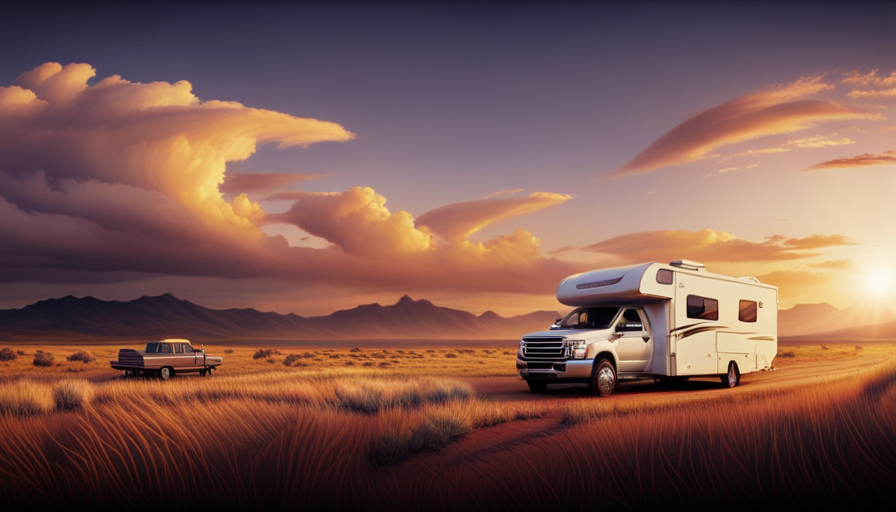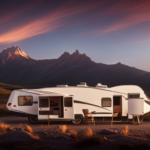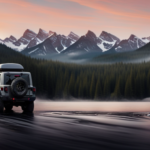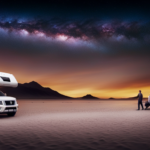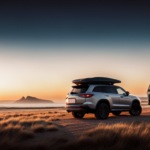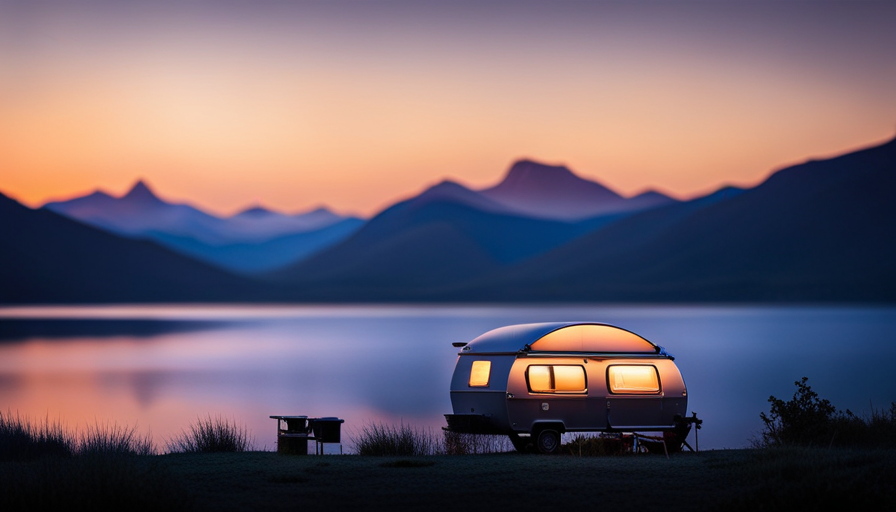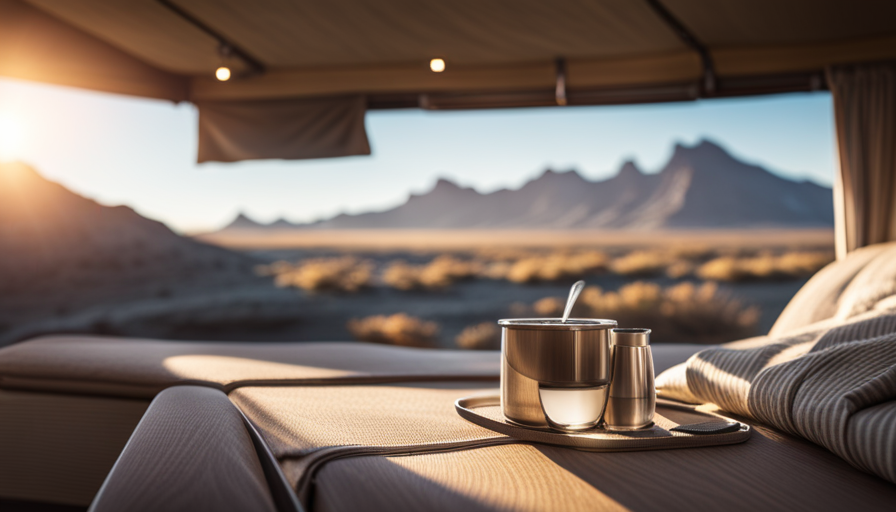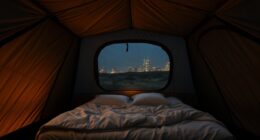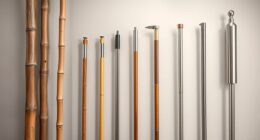Imagine setting out on an expedition, a road adventure brimming with thrills and wonders. However, there’s a twist – you’re pulling a camper along. While you traverse across freeways and serpentine paths, the bulk and dimensions of your camper might pose a significant challenge.
Fear not, for we have the knowledge to guide you through this towing endeavor.
Understanding the weight and size of your camper is crucial. It sets the foundation for a safe and smooth journey. Checking your vehicle’s towing capacity is equally important, ensuring that it can handle the load you’re about to pull.
To connect your camper securely to your vehicle, choosing the right hitch and trailer wiring is essential. And when it comes to loading and distributing weight inside the camper, proper technique is key to maintaining stability on the road.
But knowledge alone is not enough. Practice towing in a safe and open area, honing your skills and building confidence. Always remember to use mirrors and check blind spots regularly, keeping a vigilant eye on your surroundings.
Maintaining proper tire pressure and checking for wear is crucial for a smooth ride. And when faced with hills and curves, taking precautions will help you navigate them with ease.
Above all, it’s important to follow safety guidelines and regulations, ensuring the well-being of yourself and others on the road. So, buckle up and let us guide you through the ins and outs of towing a camper, turning your road trip dreams into a reality.
Key Takeaways
- Understand the importance of weight and size for a safe road trip with a camper
- Choose the right towing equipment and ensure proper installation and maintenance
- Practice towing in a safe area to build skills and familiarize with the camper
- Adjust driving habits, speed, and braking distance when towing to ensure safety
Understand the Weight and Size of Your Camper
Now that you’ve chosen your dream camper, it’s time to understand how much weight and size you’ll be dealing with.
Calculating the weight of your camper is crucial to ensure that your towing vehicle can handle it safely. First, you need to determine the weight of the empty camper. This can usually be found in the owner’s manual or on the manufacturer’s website. Once you have this information, you’ll need to factor in the weight of any additional items you’ll be carrying, such as food, water, and camping gear. Add these weights together to get the total weight of your loaded camper.
Understanding your vehicle’s towing capacity is equally important. This refers to the maximum weight that your vehicle can safely tow. You can find this information in your vehicle’s owner’s manual or by contacting the manufacturer. It’s crucial to never exceed this capacity, as it can lead to dangerous situations on the road. Exceeding your vehicle’s towing capacity can strain your engine, transmission, and brakes, putting you and other drivers at risk.
Now that you have a clear understanding of the weight and size of your camper, it’s time to check your vehicle’s towing capacity.
Check Your Vehicle’s Towing Capacity
First, you’ll want to make sure your vehicle can handle the weight of the trailer you’re planning to pull. It’s crucial to check your vehicle’s towing capacity before embarking on any towing journey.
This information can usually be found in your vehicle’s owner manual or by contacting the manufacturer. Overloading your vehicle can lead to serious safety hazards and potential damage to your vehicle.
To ensure your vehicle is ready for towing, it’s important to maintain it properly. Regular vehicle maintenance, such as checking the brakes, tires, and suspension, is crucial for safe towing. Make sure all fluids are at the recommended levels, and inspect the cooling system to prevent overheating during long trips.
Additionally, you’ll need to invest in the right towing equipment. This includes a towing hitch, which connects your vehicle to the camper, and trailer wiring, which allows your vehicle to communicate with the camper’s lights and brakes. Choosing the correct hitch and ensuring proper installation is essential for a secure and stable connection between your vehicle and the trailer.
With your vehicle’s towing capacity confirmed and necessary maintenance completed, it’s time to move on to choosing the right hitch and trailer wiring.
Choose the Right Hitch and Trailer Wiring
To ensure a secure and stable connection between your vehicle and the trailer, it’s crucial to choose the right hitch and trailer wiring. The hitch is the component that physically connects the trailer to the vehicle, and it plays a vital role in maintaining stability during towing.
It’s important to select a hitch that matches your vehicle’s towing capacity and is compatible with the trailer’s tongue weight. Additionally, the hitch should be properly installed and securely fastened to the vehicle’s frame.
Trailer wiring is another essential aspect to consider. It allows for the transmission of signals between the vehicle and the trailer, enabling the proper functioning of lights, brakes, and other electrical components. It’s crucial to ensure that the trailer wiring is in good condition and properly connected to both the vehicle and the trailer. Regular inspection and maintenance of the wiring system can help prevent any potential issues that may arise during towing.
When choosing a hitch and trailer wiring, it’s important to prioritize safety precautions. This includes using quality materials and components, following manufacturer guidelines, and seeking professional assistance if needed. By taking these measures, you can ensure a safe and efficient towing experience.
Transition: Now that you’ve chosen the right hitch and trailer wiring, it’s time to properly load and distribute weight in the camper.
Properly Load and Distribute Weight in the Camper
Make sure you evenly distribute the weight throughout your home away from home, so you don’t end up with a lopsided, wobbly ride. Properly loading and distributing weight in the camper is crucial for safe and stable towing. Here are five key loading techniques to keep in mind:
-
Balance the load: Place heavier items in the center of the camper, distributing weight evenly from side to side. This will help maintain stability and prevent swaying during travel.
-
Use storage compartments wisely: Utilize the available storage compartments strategically to evenly spread out the weight. Avoid overloading any single compartment, as it can lead to an imbalanced trailer.
-
Secure loose items: Ensure that all loose items inside the camper are properly secured to prevent shifting during transit. Use bungee cords, cargo nets, or straps to secure items and minimize movement.
-
Consider tongue weight: The tongue weight, or the downward force on the hitch ball, should typically be around 10-15% of the total trailer weight. Adjust the load distribution to achieve the recommended tongue weight.
-
Check tire pressure: Maintain proper tire pressure on all camper tires to support even weight distribution and prevent excessive wear.
By following these loading techniques and distributing the weight evenly, you’ll have a smoother and more controlled towing experience. Once you’ve mastered this aspect, you can move on to practicing towing in a safe and open area.
Practice Towing in a Safe and Open Area
Once you’ve mastered the proper weight distribution, it’s time to put your skills to the test and practice towing in a safe and open area. Practicing towing techniques is crucial to ensure you’re comfortable and confident when towing your camper on the road.
Before you start, make sure you have all the necessary towing equipment, such as a reliable hitch, safety chains, and trailer brakes if required.
Begin by finding a spacious area, like an empty parking lot or a quiet road, where you can practice maneuvering your camper. Start by learning how to make wide turns and navigate corners smoothly. Practice backing up in a straight line and then progress to backing up around obstacles. This will help you develop the necessary skills to handle different towing scenarios.
During your practice sessions, pay close attention to your mirrors and the position of your camper. Adjust your speed and braking distance to account for the added weight and longer stopping distances. Get a feel for how your camper responds to acceleration, braking, and steering inputs.
By practicing these techniques, you’ll become more comfortable and proficient in towing your camper. Once you feel confident in your abilities, you can move on to the next step: adjusting your driving habits for towing.
Adjust Your Driving Habits for Towing
After gaining confidence in towing a camper in a safe and open area, it’s time to take the next step and adjust our driving habits for towing.
It’s important to understand that towing a camper significantly impacts the handling and braking capabilities of our vehicle. Therefore, we need to make some necessary adjustments to ensure a safe and smooth journey.
First and foremost, we must be mindful of our speed when towing. Due to the added weight and increased wind resistance, our vehicle will require more time to accelerate and decelerate. It’s advisable to drive at a slower speed compared to when we’re not towing. This will give us better control over the camper and reduce the risk of accidents.
When it comes to braking, we need to adopt different techniques. Instead of relying solely on the vehicle’s brakes, we should use the trailer brakes, if available, to evenly distribute the braking force. This will prevent the camper from pushing the vehicle forward and potentially causing a loss of control. Additionally, we should avoid sudden or aggressive braking maneuvers, as they can destabilize the entire setup.
Adjusting our speed and mastering proper braking techniques are crucial aspects of towing a camper safely. By doing so, we can ensure a smoother and more controlled driving experience.
Now, let’s move on to the next section and learn about using mirrors and checking blind spots regularly.
Use Mirrors and Check Blind Spots Regularly
Don’t you just love the thrill of not knowing what’s lurking in your blind spots and the excitement of relying solely on your mirrors while driving? When towing a camper, it becomes even more crucial to check your blind spots and adjust your mirrors properly. By doing so, you ensure the safety of everyone on the road.
To effectively check blind spots, start by adjusting your side mirrors outward. This widens your field of view and minimizes blind spots. Make sure you can see the edge of your camper in the mirrors without moving your head. Additionally, use your rearview mirror to monitor the traffic behind you.
While driving, regularly check your blind spots by quickly glancing over your shoulder. This allows you to see any vehicles or obstacles that may not be visible in the mirrors. Remember, a quick shoulder check is essential, especially when changing lanes or making turns.
Maintaining proper tire pressure and checking for wear is crucial for the overall safety and performance of your camper. By regularly monitoring tire pressure, you can prevent blowouts and ensure a smooth ride. Additionally, checking for tire wear helps identify any potential issues before they become major problems.
Transitioning into the next section, let’s talk about how to maintain proper tire pressure and check for wear.
Maintain Proper Tire Pressure and Check for Wear
Ensure a smooth and safe journey by regularly monitoring your tire pressure and checking for wear, allowing you to glide down the road with confidence.
Proper tire maintenance is essential when towing a camper, as it directly impacts both your vehicle’s performance and your overall safety. Start by inspecting your tires before each trip, ensuring they’re properly inflated according to the manufacturer’s recommendations.
Underinflated tires can lead to poor handling, increased fuel consumption, and potential blowouts. Conversely, overinflated tires can result in a harsh ride and reduced traction.
In addition to checking the tire pressure, it’s crucial to examine the tires for signs of wear and tear. Look for uneven tread wear, bulges, cracks, or any other abnormalities. Uneven wear may indicate improper alignment, suspension issues, or overloading. If any of these conditions are present, it’s necessary to address them promptly to avoid further damage and potential tire failure.
Regularly rotating your tires can also help ensure even wear and extend their lifespan.
By maintaining proper tire pressure and checking for wear, you can minimize the risk of tire-related incidents and enjoy a smoother towing experience. With your tires in optimal condition, you can confidently navigate through hills and curves, ensuring a safe and enjoyable journey for you and your fellow travelers.
Take Precautions for Hills and Curves
Prepare yourself for a thrilling rollercoaster ride as you navigate the twists and turns of hills and curves, ensuring a smooth and exhilarating journey. When towing a camper, it’s crucial to take precautions to prevent sway and manage your speed effectively.
Sway can occur when the wind pushes against your camper, causing it to sway side to side. To prevent this, make sure your camper is properly loaded and balanced. Distribute the weight evenly and secure any loose items to minimize movement. Additionally, consider using sway control devices, such as sway bars or weight distribution hitches, to help stabilize the camper and reduce sway.
As you approach hills and curves, it’s essential to manage your speed appropriately. Slow down before entering a curve to maintain control and prevent fishtailing. Keep in mind that the weight of your camper can affect your braking distance, so allow for extra space between you and the vehicle in front of you. Be cautious when descending hills and use the appropriate gears to control your speed. Avoid riding your brakes for extended periods, as this can cause them to overheat and potentially fail.
Taking these precautions for hills and curves will ensure a safe and enjoyable towing experience.
Now, let’s move on to the next section, where we’ll discuss the importance of following safety guidelines and regulations without compromising your adventure.
Follow Safety Guidelines and Regulations
While navigating hills and curves, it’s crucial to adhere to safety guidelines and regulations to ensure a worry-free and enjoyable journey. Understanding towing equipment and choosing the right towing vehicle are essential aspects to consider when towing a camper. Here are some key points to keep in mind:
-
Understanding towing equipment: Familiarize yourself with the various components of the towing system, such as the hitch, coupler, safety chains, and brake controller. Ensure that all equipment is properly installed and in good working condition. Regularly inspect and maintain the towing equipment to prevent any potential issues during your trip.
-
Choosing the right towing vehicle: Select a vehicle that has the appropriate towing capacity for your camper. Consider factors such as the weight of the camper, the vehicle’s engine power and torque, as well as its suspension and braking capabilities. Consult the vehicle’s manufacturer guidelines and consult with professionals if needed to ensure a proper match between the vehicle and the camper.
-
Follow weight distribution guidelines: Distribute the weight of the camper evenly and properly using weight distribution hitches. This will help prevent swaying and maintain stability while towing, especially when navigating hills and curves.
-
Observe speed limits and traffic regulations: Adhere to posted speed limits and traffic rules at all times. Reduce your speed when approaching curves or going downhill to maintain control and prevent accidents.
By following these safety guidelines and regulations, and having a good understanding of towing equipment and choosing the right towing vehicle, you can have a smooth and worry-free journey while towing a camper.
Frequently Asked Questions
How do I properly load and distribute weight in my camper?
Proper camper loading is crucial for safe and stable towing. Let’s talk weight distribution techniques.
One interesting statistic: Did you know that more than 60% of camper accidents are caused by improper loading? To ensure balance, distribute weight evenly from front to back and side to side.
Use a tongue weight scale to determine the ideal weight on the hitch. Consider using leveling blocks or a weight distribution hitch to evenly distribute weight.
What are some driving habits I should adjust when towing a camper?
When towing a camper, we need to make certain adjustments to our driving habits. Firstly, we must be mindful of adjusting our speed to accommodate the added weight and longer braking distances.
It’s crucial to maintain a safe and steady pace, avoiding sudden acceleration or deceleration. Additionally, we should adopt proper braking techniques, such as applying brakes earlier and with gentle pressure to ensure a controlled and stable stop.
These adjustments are vital for a safe towing experience.
How do I use mirrors and check blind spots regularly while towing a camper?
To ensure safe towing, it’s crucial to master using mirrors effectively and regularly checking blind spots. Mirrors act as our eyes on the road, allowing us to see what’s happening behind us. Adjust them to cover a wide range of view, including the sides and rear of the camper.
Constantly monitor these mirrors to maintain awareness of surrounding vehicles. Moreover, remember to maintain a safe distance to avoid any potential accidents while towing a camper.
What precautions should I take when driving on hills and curves with a camper?
When driving on hills and curves with a camper, it’s crucial to employ proper driving techniques and braking methods. Maintain a steady speed and avoid sudden acceleration or deceleration to prevent swaying or fishtailing. Use the lower gears to maintain control and reduce strain on the transmission.
When descending hills, engage the engine brake or shift to a lower gear to control speed. Always anticipate curves and adjust your speed accordingly to maintain stability.
What are some important safety guidelines and regulations I should follow when towing a camper?
When towing a camper, it’s crucial to follow important safety guidelines and regulations.
Trailer sway can be a treacherous dance partner, so we must ensure our weight distribution and hitch setup are spot on.
To keep things stable, we need to control our speed and be mindful of curves and hills.
Additionally, being familiar with emergency braking techniques is vital for unexpected situations.
By adhering to these guidelines, we can tow our campers with confidence and peace of mind.
Are the Steps for Towing a Fifth Wheel Camper the Same as Towing a Regular Camper?
When it comes to towing a fifth wheel camper, the steps are not the same as towing a regular camper. Towing a fifth wheel camper requires a different hitch set-up and a bigger towing vehicle. Additionally, the maneuverability and stopping distance might differ due to the unique design of a fifth wheel camper. Thus, it is essential to understand the specific steps involved in towing a fifth wheel camper to ensure a safe and successful journey.
Conclusion
In conclusion, towing a camper requires careful consideration and attention to detail. Just like a captain navigating through rough waters, we must understand the weight and size of our camper. We also need to check our vehicle’s towing capacity and choose the right hitch and trailer wiring.
Properly loading and distributing weight, practicing in a safe area, and using mirrors and checking blind spots regularly are crucial. Maintaining tire pressure and taking precautions for hills and curves ensures a smooth journey. By following safety guidelines and regulations, we can embark on our camper adventures with confidence and peace of mind.
So, let’s set sail and explore the wonders that await us!

